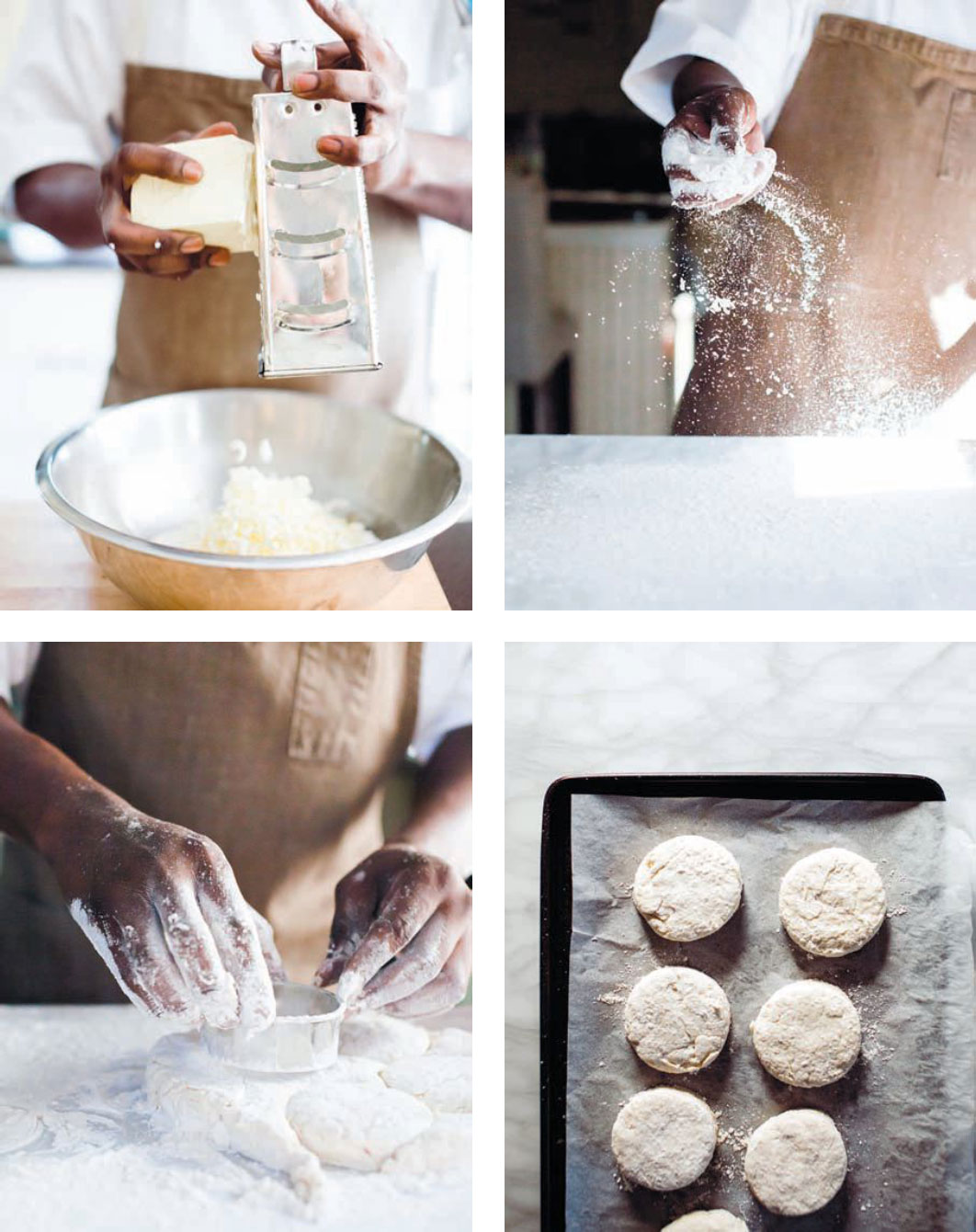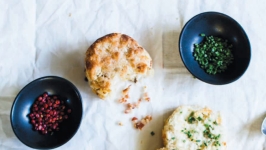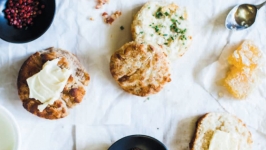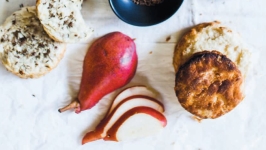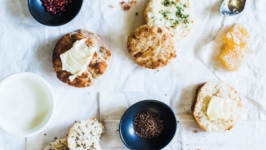A Hug On The Inside - Making biscuits six ways with Chef Nick Simpson

The first thing you’ll notice about Nick Simpson’s buttermilk biscuits is how tall they are. The warm, golden biscuits stood at least three inches off the serving plate when we ordered them from the Spoke & Steele starter menu, where Simpson serves as sous chef.
What’s the secret to these tall, light biscuits, referred to as “Nickscuits” by those who know Simpson? For starters, he leaves his dough at least an inch or an inch and a half thick when he rolls it out. Most recipes I’ve used suggest rolling or “patting” the dough down to half an inch thick. But that’s not the only trick up the sleeve of Simpson’s chef coat, and when we met to talk all things biscuits, he generously shared a few more.
Light and Fluffy
His first tip is to sift all the dry ingredients.
“You don’t want things to get dense, you don’t want things to fall. You want them to stay light and fluffy and airy,” Simpson says.
Not only does sifting make the flour light and airy, it also helps distribute the baking powder, salt and baking soda so it’s not just sitting on top.
“You want it all incorporated so every biscuit, or at least three-quarters of your tray of biscuits, will rise the same and look pretty even,” Simpson explains.
All About the Butter
Next, Simpson keeps everything cold: the ingredients, the tools, even his workspace.
“The secret for me is to keep everything cold, super cold,” Simpson says. “I like to keep the space cold, even.” The reason for all this chilling? The butter—and it’s almost always butter for Simpson, not lard, unless he’s using bacon fat for a savory biscuit.
See, Simpson doesn’t use just cold butter; he uses frozen butter, and then grates it with a cheese grater.
“I’m getting these little flakes of butter in there but nothing too heavy to reverse what I’ve done with my sifting,” Simpson explains. That means so long pastry cutter. “Nobody’s got time for that, and nobody wants arthritis from that. I set the cheese grater on the large setting and grate it in there.”
Then, he throws the whole bowl back in the freezer until his oven has preheated because once he completes the final steps, it’s a race against the clock to get them into the oven as fast as possible.
“You don’t want that butter to warm up,” Simpson says, “You want everything to stay cold so that it’s as cold as possible going into a really hot oven so the heat and the cold ‘shock’ to create a little bit of steam, and the butter starts to melt, and activate with your baking powder and baking soda and they literally … well, we skipped a step. Because you gotta add in your buttermilk.”
After he takes the dry ingredients plus butter coming out of the freezer, Simpson adds just enough cold buttermilk until the mixture holds together.
“I mean, it’s not going to be doughy like if you’re making piecrust or opening up a can of grocery-story biscuits. That’s too much liquid for this recipe,” Simpson says, of his signature buttermilk biscuits. “You want it to just barely be holding together and all of your ingredients have come off the wall of the bowl and you may see a little residue down in the bottom of your dry mixture. That’s perfect. Just until it holds together.”
Flour Everything
At this point, Simpson suggests flouring everything—your workspace, your hands and your rolling pin—and working with a “feather touch,” gently patting the dough then rolling it, using only the weight of the rolling pin and gravity to apply pressure. The biscuit cutter also should be well-floured, dipping it over and over into flour with each cut and pushing down and straight back up, never turning it.
“You’ve seen biscuits that rise tall and even, kind of like a cake, but then you’ve seen some that kind of fold over. It’s been pinched,” Simpson says. “And usually it gets pinched because your cutter is sticking to the dough when you try to cut through it, and when it pinches the dough, that one side doesn’t rise as well as the rest of it does. That’s why I keep it dry and dusted.”
Gorgeous and Golden
Finally, Simpson bakes his buttermilk biscuits on a parchment-covered baking sheet in a very hot oven—450° in his professional convection oven—for four to five minutes, creating that instant shock of cold to hot that forces the biscuits to almost double in size. Then he turns the oven down to 350 and bakes them six to seven more minutes to finish the process.
“Then you’ll have this gorgeous, golden, maybe even sunburst orange color where the butter has really worked its way through the whole thing,” Simpson says. “I don’t brush it, I don’t put any buttermilk on top, I don’t put any butter on top. I don’t put anything on it. All those ingredients and that process is all it is. There’s enough butter in there that it seeps through the biscuit and it gives it its own coating. You don’t have to use any other coating.”
Simpson makes 50–70 biscuits a day in his current job, more on the weekends for brunch. It takes him a little less than an hour to make biscuits for a day’s dinner service, breaking them down into two batches so he doesn’t overwork or overheat the dough and so he can more evenly distribute the chemicals in the flour.
“With a batch that big, you’re going to have pockets of baking powder and baking soda in places where you want it mixed together,” Simpson says. “There’s too many opportunities to mess it up when you work with batches that big.”
Simple Is Best
The popularity of Simpson’s buttermilk biscuits came as a bit of surprise to the chef, mostly because he grew up eating them for breakfast and helping his mom make them for his family’s Sunday dinners. He doesn’t remember the first time he made a batch on his own, but he does remember helping with the sifting or watching his mom cut biscuits with the top of a glass when he was very young.
The buttermilk biscuit recipe he uses today is based on the simple process his mom used to make biscuits, just six ingredients. “A good biscuit and a good recipe doesn’t need all that other stuff that people do or tell you that you have to do for it to turn out right,” Simpson says. “There’s beauty in simplicity, it doesn’t need all that.”
Just How You Do Things
In fact, Simpson says learning to make biscuits from his mom in her Alabama kitchen was just part of the broader culinary education he received during his childhood, skills that weren’t thought of as “techniques” back then; it was “just how you do things.”
“In the South, they don’t know ‘you need this amount of baking powder with a little bit of baking soda,’ and ‘don’t forget your salt to make your baking work out right,’” Simpson says. “They just [relied on] trial and error and knew they needed a little bit of this and little bit of that, not knowing they’ve already learned the science behind cooking.”
In fact, Simpson didn’t go to culinary school to get to where he is today. He studied music in college. But when he got “tired of chasing money” in his music career, he found himself working in a kitchen with all the skills he needed because he’d grown up cooking with his mom.
A Hug on the Inside
“When I started baking and cooking professionally, it was just, like, ‘I know how to do this,’” Simpson says. “I do a lot of comfort food, not necessarily because it’s comfort food but because I grew up in the South. Growing up in the South, it’s all comfort food. You spend a lot of time in the kitchen, whether it’s doing homework, whether it’s helping Mom with dinner, getting disciplined in the kitchen, fellowshipping, learning life lessons and getting those lectures, a lot of that happened in the kitchen. So for me, I like my food to give you a hug on the inside and tell you a story because usually that’s what happens in the kitchen.”
And that’s just what Simpson’s biscuits do, especially served warm with a little butter and honey.
In fact, they might just make you want to hug Simpson back.
